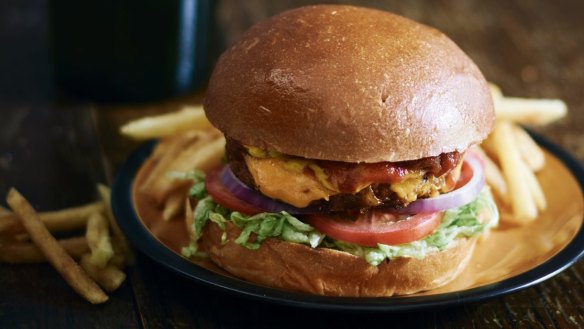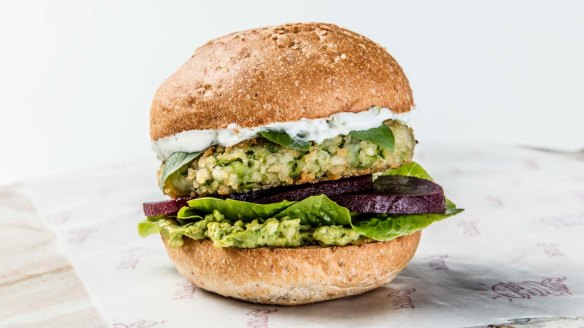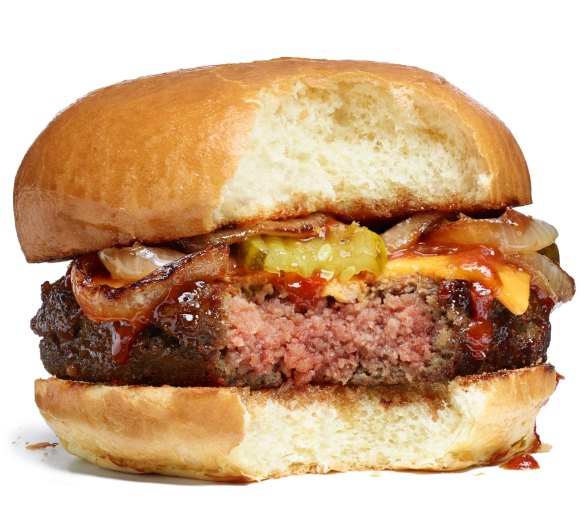Meet the meatless butcher and modern meat-free burgers

It's a lunchtime on a weekday in the Netherlands city of The Hague. A short walk from the Centraal train station is a pretty little shop with marble counters and painted wooden fittings. With tiles and sets of scales, it looks like a modern northern European butcher's shop. Except there is no meat. Just food that looks exactly like grilled chicken, mincemeat, meat balls, burger patties, tuna, speck, bacon and bratwurst, and all created from plants.
This is the concept store of De Vegetarische Slager or, in English, the Vegetarian Butcher.
Started in 2010, this meatless butcher now has a restaurant and several hundred outlets across continental Europe, Britain, the Caribbean and Asia.

"Back in 1998 there was an outbreak of swine fever," says founder Jaap Korteweg. A ninth-generation farmer, he is a fit middle-aged man with a shaved head and a dry Dutch sense of humour. "I decided to refrain from eating animals," he says.
"However, I had this constant craving for the taste, the bite and the texture of meat."
For the next decade Korteweg sought out scientists and manufacturers of vegetable protein to find a way to make meat substitutes that not only looked, smelled and tasted like meat but also mimicked the texture of animal flesh.

His products are remarkably good. The chicken skewers have a mouthfeel like everyday factory-farmed chicken and the flavour is remarkably close to actual chicken although it is made from layers of soy protein concentrate, vegetable oil and "flavour".
The MC2 burger patty is thick, juicy and has a beefy flavour, despite being made from soy and wheat protein, vegetable oil, spices, yeast, thickeners and flavours. In a bun with lettuce and tomato, the MC2 burger is an incredibly convincing stand in for meat. I give a nod of approval. Korteweg gives a little smile of appreciation.
Meat substitutes are nothing new. Tofu, for example, was referred to in the 9th century as "mock lamb chops" or "the vice mayor's mutton". A technique for mock meat, developed by the Chinese in the 14th century, is still used today and is the basis of many of the meat substitutes on the market.
New technology has seen the development of other products such as textured vegetable protein (TVP), a beige substance made from soybeans once they have been processed for oil extraction.
The fibre and protein is turned into a slurry and heated to 200 degrees to denature the proteins. It's then extruded through a nozzle under pressure and when it hits the air, the change in pressure makes it expand to a light, spongy material. It can be formed into different shapes and flavoured with yeast or vegetable extracts and amino acids.
Another modern meat replacement is Quorn. Developed by British industrialist J. Arthur Rank (he also started Rank Films) during the 1960s when the threat of global starvation seemed real, he asked his team of food scientists at Rank Hovis McDougall to work with the boffins at ICI to create a food from fungus. They chose Fusarium venenatum, which was eventually grown in giant tanks of glucose and minerals, filtered and mixed with egg white, seasonings and flavourings and is shaped into chunks, sausages, schnitzels and mince. It has been sold in Australia since 2010.
While mock meats deliver a mixed bag of quality dining experience from truly delicious and satisfying to rubbery textures and petrochemical aromas, some of the best developments in fake meat come from the world of burgers.
Replicating ground meat is easier than trying to copy layers of muscle found in steak, plus burgers are almost always served with loads of mustard, mayo, cheese and tomato sauce. The Impossible Burger, developed in the United States, is considered one of the best in the world and uses an extract from the root nodules of legumes called leghemoglobin to replicate haemoglobin – the blood in meat. This soy-based product is added to a mix of textured wheat protein, potato protein, gums and flavours.
The other exciting burger to come from the States is the Beyond Burger, formulated using pea protein isolate but also a lot of vegetable oil – canola and coconut – the fat making up 22 per cent of the mass of the burger – just like a beef burger. It is flavoured with spinach, broccoli, carrot, tomato, beetroot and shiitake mushroom extract, the colour from the beetroot melding with the fats and dripping out like blood.
The Impossible Burger is the inspiration for the Australian Grill'd group's new Amazing Vegan Cheeseburger. Grill'd eschews soy in all its dishes and has instead opted for protein sourced from peas and blended with chickpeas, teff and rice flour, along with canola oil for mouthfeel and beetroot powder and yeast extract for flavour. Along with vegan cheese and mayo, dill pickles and lettuce, the result is a flavour-packed burger.
"We understand there are food tribes and this [new offer] appeals not only to the 10 per cent to 12 per cent of Australians who identify as vegetarian or vegan but to the growing number of flexitarians," says Trent Bos, head of brand and innovation with Grill'd. "The real push is coming from the Millennials. They recognise the threat of climate change and are wanting to do something about it so are making the decision to eat plant-based foods."
He pushes forward another burger. It's called Hemp Therapea. It is made from pea protein, fava bean flour, oil-rich hemp seeds and flavoured with mint. Served in a bun with tzatziki, lettuce and sous-vide beetroot, the burger is greater than the sum of its parts. It is meaty, tasty, lingeringly delicious and a truly great alternative.
Restaurant reviews, news and the hottest openings served to your inbox.
Sign up- More:
- Restaurant news
